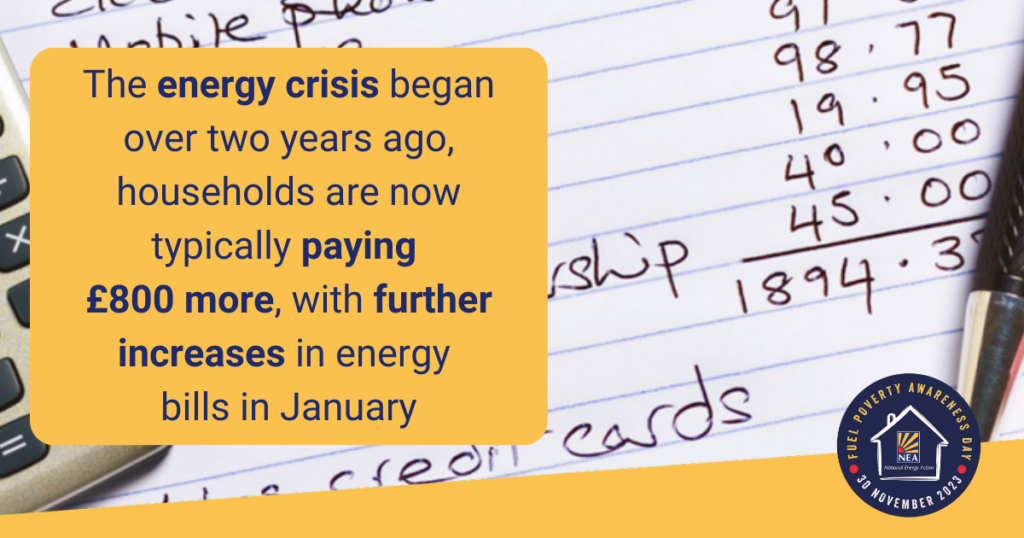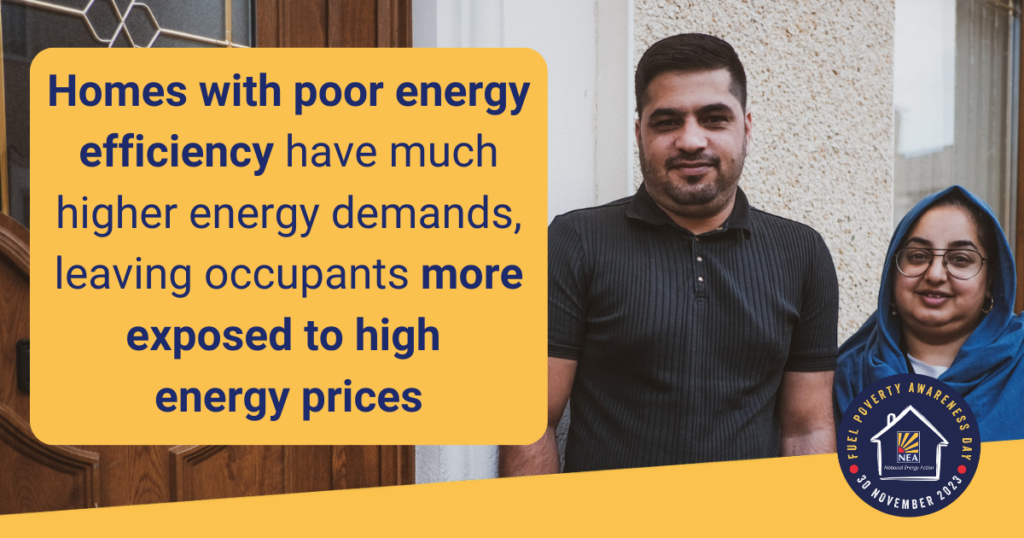#FuelPovertyAwarenessDay
On Thursday 30th, November 2023, it’s #FuelPovertyAwarenessDay created by National Energy Action, which is designed to raise awareness of fuel poverty in the UK. It’s been two years since the energy crisis first began, and since 1 October, 6.3 million UK households have been in fuel poverty.
National Energy Action – Is dedicated to ending fuel poverty in England, Wales and Northern Ireland. They also work closely with Energy Action Scotland and have recently expressed concern that homes across the UK are substandard and are increasing energy costs – at a time when temperatures are dropping and heating bills are rising. In some parts of the UK, some 40% of homes have inadequate loft insulation, and 36% have inadequate wall insulation. These figures were from homes in Staffordshire, but they will also be similar in many other parts of the UK.

What is fuel poverty?
The general definition of fuel poverty is when a household needs to spend 10% or more of its total household income on energy in order to maintain a satisfactory heating regime. The average household income in the UK in 2023 is around £33,000 pa. If this is coming from one earner in the household, that is an approximate take-home pay of around £2,200 a month. If you’re energy bills are 10% of this, £220, you can be considered to be in fuel poverty. The figure of £220 a month for energy is by no means excessive. It may have been a few years back. But not now, which is quite worrying.

Cold Homes = Poor Heath (and more)
Staying warm isn’t just a comforting “nice to have” luxury – it’s vital and, for some, a life-support. Homes which are cold can exacerbate health conditions, some extremely serious, including heart attacks, strokes, asthma and other respiratory illnesses, not to mention the mental health impact. It’s estimated that some 10,000 people die each year as a result of living in a cold home. A cold home does not only impact health. It can have significant issues for children. Without a warm home to do homework, they can easily fall behind at school. A lack of hot water can also mean they avoid personal care, which in some circumstances can lead to bullying and social exclusion issues.
Fuel Poverty by Region:
Fuel poverty exists across the UK. Below is an overview of how these issues are impacting on a more localised level.
Notes – EPC = Energy Performance Certificate. Ratings range from A (very efficient) to G (very inefficient). Anything less than a C rating (D to G) is considered poor.
North East – 14.4% in fuel poverty. 49% of households rated EPC C or above
North West – 14.4% in fuel poverty. 49% of households rated EPC C or above
Yorkshire & The Humber – 17.5% in fuel poverty. 40% of households rated EPC C or above
East Midlands – 14.2% in fuel poverty. 41% of households rated EPC C or above
West Midlands – 17.8% in fuel poverty. 41% of households rated EPC C or above
South West – 11.4% in fuel poverty. 45% of households rated EPC C or above
South East – 8.6% in fuel poverty. 50% of households rated EPC C or above
London – 11.5% in fuel poverty. 53% of households rated EPC C or above
East of England – 13.2% in fuel poverty. 47% of households rated EPC C or above
5 Useful Tips on Keeping Warm for Less:
1. Thick Curtains – One of the best ways to keep your home warm in the winter is to have thick curtains. Many homes, especially those that don’t have double glazing, will lose a considerable amount of heat through windows. As curtains are designed to cover windows, it makes perfect sense to ensure you have thick curtains for the winter. Some curtains do have thermal linings, so you don’t necessarily need to go ultra-thick to keep warm.
2. Giving Radiators Space – Make sure you keep your radiators away from the furniture. Having your sofa right up against the radiator may look cosy, but it will absorb a great deal of heat. Giving your radiator a little space will allow all the heat to warm the room up. You can also further help a radiator become even more efficient by fitting reflective foil at the back, allowing it to reflect heat away from the wall it sits on back into the room.
3. Small Drafts – There are a number of small drafts around the home, which can all contribute to heat loss. Examples are letterboxes, where brush closers are ideal for stopping junk mail leaflets and also stopping excessive drafts. Keyhole covers are great at stopping drafts through keyholes – especially with older homes, which may have more traditional, larger locks fitted. Small drafts in windows can be tackled by fitting double glazing film, which, although is not as good as the real thing, is a great deal cheaper.
4. Getting Your Timing Right – If you are experiencing very cold weather, consider setting your heating to come on before you arrive home to allow the house to become warm, as opposed to arriving home, feeling cold, and putting the temperature right up (much warmer than you usually have it) to get warm. Having the heating on for longer, with a lower, more stable temperature, will be much more fuel-efficient and more comfortable than shorter hot blasts.
5. Switch Between Hot & Cold – A hot shower may warm you up on a cold morning. However, a cold shower will help improve blood flow between your skin and organs, plus talking cold showers are also correlated with an improved immune system. If taking a cold shower is too much, then switch between hot and cold and see how that helps you. Using less hot water will save you money, too.








